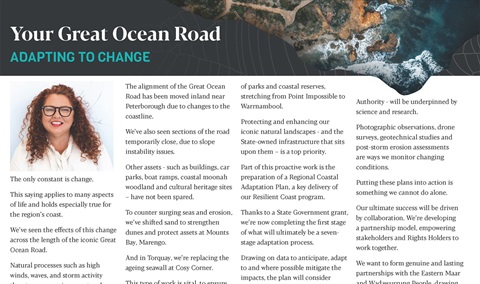Adapting to Change
Published on 14 June 2024

The only constant is change.
This saying applies to many aspects of life and holds especially true for the region’s coast.
We’ve seen the effects of this change across the length of the iconic Great Ocean Road.
Natural processes such as high winds, waves, and storm activity threatens our environment and the infrastructure that helps all of us enjoy this beautiful part of the world.
These ‘hazards’ not only alter the physical landscape but are already changing how we can access and use the coast.
Shifting sand and cliff erosion has led to the closure or relocation of much-loved beach access points.
We’ve had to move sections of the Surf Coast Walk at Anglesea and Aireys Inlet inland and are preparing to do the same near Rocky Point in Torquay.
The alignment of the Great Ocean Road has been moved inland near Peterborough due to changes to the coastline.
We’ve also seen sections of the road temporarily close, due to slope instability issues.
Other assets - such as buildings, car parks, boat ramps, coastal moonah woodland and cultural heritage sites have not been spared.
To counter surging seas and erosion, we’ve shifted sand to strengthen dunes and protect assets at Mounts Bay, Marengo.
And in Torquay, we’re replacing the ageing seawall at Cosy Corner.
This type of work is vital, to ensure the safety of our community and integrity of our assets.
But with a changing climate, we must continue to adapt and prepare for increased wave action, storm activity and sea level rise.
This is about more than saving the road.
A proactive and strategic approach to adapt to coastal hazards is required to ensure the values of the region are retained.
As of November 2025, the Authority will be managing 150,000 hectares of parks and coastal reserves, stretching from Point Impossible to Warrnambool.
Protecting and enhancing ouriconic natural landscapes - and the State-owned infrastructure that sits upon them – is a top priority.
Part of this proactive work is the preparation of a Regional Coastal Adaptation Plan, a key delivery of our Resilient Coast program.
Thanks to a State Government grant, we’re now completing the first stage of what will ultimately be a seven stage adaptation process.
Drawing on data to anticipate, adapt to and where possible mitigate the impacts, the plan will consider measures such as:
- Identifying suitable locations for community infrastructure
- Adapting design responses to limit the infrastructure’s exposure
- Building or enhancing physical barriers to protect assets
- Relocating infrastructure that is impacted or threatened by erosion; and
- Nourishing beaches and sand dunes, and revegetating areas
This work – like all we do at the Great Ocean Road Coast and Parks Authority - will be underpinned by science and research.
Photographic observations, drone surveys, geo-technical studies and post-storm erosion assessments are ways we monitor changing conditions.
Putting these plans into action is something we cannot do alone.
Our ultimate success will be driven by collaboration. We’re developing a partnership model, empowering stakeholders and Rights Holders to work together.
We want to form genuine and lasting partnerships with the Eastern Maar and Wadawurrung People, drawing on their culture and connections to Country to inform our plans.
We know our coastline is forever dynamic. We are focused on ensuring it is resilient and sustainable - for the biodiversity it hosts, the communities it supports and the visitors it attracts.
Together, we’re forging a path towards a more resilient future for the Great Ocean Road, now and for generations to come.
- Jodie Sizer, CEO